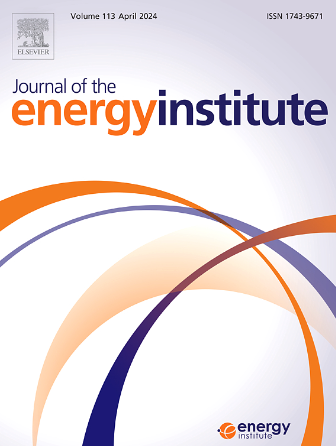不同纳米颗粒注入生物柴油/柴油混合物对内燃机燃烧、性能和环境特性的协同效应
IF 5.6
2区 工程技术
Q2 ENERGY & FUELS
引用次数: 0
摘要
对传统柴油的可持续和绿色替代品的需求不断增长,推动了对生物柴油混合物的研究,纳米颗粒添加剂可以提高燃烧效率和减少排放。本研究探讨了使用生物柴油-混合氧化石墨烯(GO)、氧化镁(MgO)和多壁碳纳米管(MWCNT)纳米颗粒的柴油发动机的性能、燃烧和排放特性。以80%的柴油和20%的废食用油驱动的生物柴油为原料制备了B20生物柴油混合物,并在90 ppm的浓度下使用水浴声呐添加纳米颗粒以达到适当的分散。发动机测试在可变负载条件下进行,测试混合物(B20、B20+GO、B20+MgO和B20+MWCNT),并与基线柴油(D100)进行比较。结果显示,与不含纳米颗粒的D100和B20混合物相比,纳米颗粒分散的生物柴油混合物在发动机性能和燃烧效率方面有显著提高。与基准柴油相比,B20+MWCNT混合燃料的BTE提高了12.40%,BSFC降低了9.67%。此外,该混合物具有更高的热释放率(HRR),峰值气缸压力(PCP)和排气温度(EGT)。与满载工况下的基准柴油相比,CO、CO2、UBHC和NOx的排放量分别下降了60%、16%、36.84%和9.02%。这项研究强调了纳米颗粒增强的生物柴油混合物在提高发动机效率的同时减少有害排放的潜力。本文章由计算机程序翻译,如有差异,请以英文原文为准。

Synergistic effect of various nanoparticles infused biodiesel/diesel blends on combustion, performance, and environmental characteristics of a CI engine
The growing demand for sustainable and green alternatives to conventional diesel has driven the search of biodiesel blends, with nanoparticle additives improving combustion efficiency and emission reduction. This study explores the performance, combustion, and emissions characteristics of a diesel engine using biodiesel-diesel blended with graphene oxide (GO), magnesium oxide (MgO), and multi-walled carbon nanotubes (MWCNT) nanoparticles. The B20 biodiesel blend was prepared with 80 % diesel and 20 % waste cooking oil-driven biodiesel, and the nanoparticles were added at 90 ppm using a water bath sonicator for proper dispersion. Engine tests were conducted under variable load conditions for test blends (B20, B20+GO, B20+MgO, and B20+MWCNT) and compared with baseline diesel (D100). The results exhibited substantial enhancements in engine performance and combustion efficiency for nanoparticle-dispersed biodiesel blends as compared to D100 and B20 blends without nanoparticles. The B20+MWCNT blend achieved a 12.40 % higher BTE and a 9.67 % lower in BSFC compared to baseline diesel. Additionally, this blend presented higher heat release rate (HRR), peak cylinder pressure (PCP), and exhaust gas temperature (EGT). Emission reductions were observed, with CO, CO2, UBHC, and NOx emissions decreasing by 60 %, 16 %, 36.84 %, and 9.02 %, respectively, compared to baseline diesel at full load condition. The study emphasizes the potential of nanoparticle-enhanced biodiesel blends to enhance engine efficiency while reducing harmful emissions.
求助全文
通过发布文献求助,成功后即可免费获取论文全文。
去求助
来源期刊

Journal of The Energy Institute
工程技术-能源与燃料
CiteScore
10.60
自引率
5.30%
发文量
166
审稿时长
16 days
期刊介绍:
The Journal of the Energy Institute provides peer reviewed coverage of original high quality research on energy, engineering and technology.The coverage is broad and the main areas of interest include:
Combustion engineering and associated technologies; process heating; power generation; engines and propulsion; emissions and environmental pollution control; clean coal technologies; carbon abatement technologies
Emissions and environmental pollution control; safety and hazards;
Clean coal technologies; carbon abatement technologies, including carbon capture and storage, CCS;
Petroleum engineering and fuel quality, including storage and transport
Alternative energy sources; biomass utilisation and biomass conversion technologies; energy from waste, incineration and recycling
Energy conversion, energy recovery and energy efficiency; space heating, fuel cells, heat pumps and cooling systems
Energy storage
The journal''s coverage reflects changes in energy technology that result from the transition to more efficient energy production and end use together with reduced carbon emission.
 求助内容:
求助内容: 应助结果提醒方式:
应助结果提醒方式:


